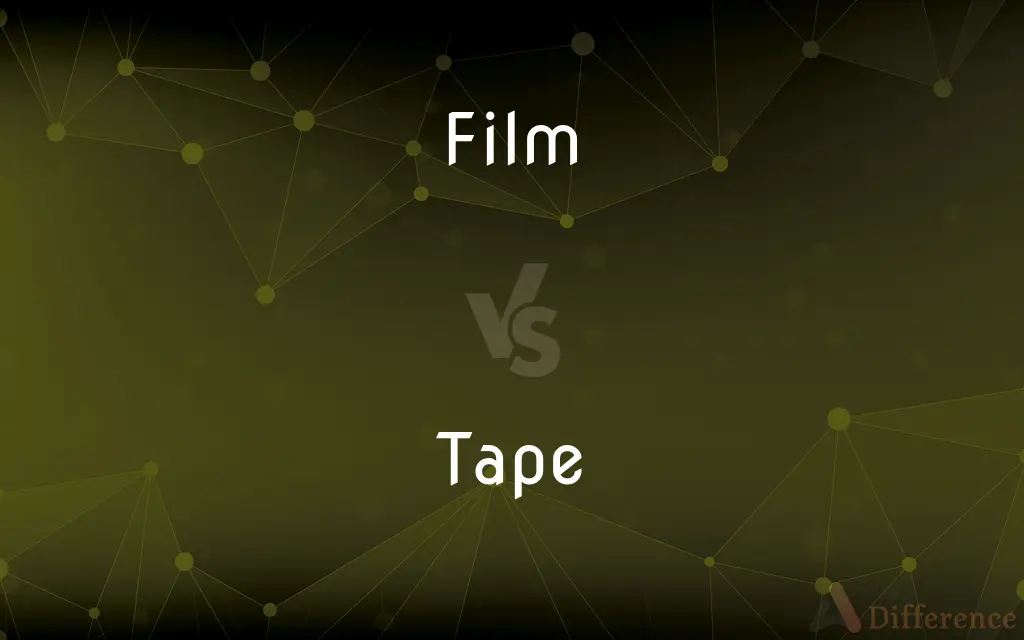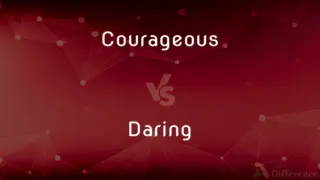Film vs. Tape — What's the Difference?
By Urooj Arif & Fiza Rafique — Updated on April 4, 2024
Film is a medium historically used for capturing and projecting movies, relying on photochemical processes, while tape refers to magnetic tape used for recording audio and video in an analog or digital format.

Difference Between Film and Tape
Table of Contents
ADVERTISEMENT
Key Differences
Film, made from cellulose acetate and used in photography and cinematography, captures images through a chemical reaction to light. This photochemical process creates a visual record that can be developed and projected. On the other hand, tape, consisting of magnetic coating on a plastic base, records audio and video through the alignment of magnetic particles, which can be played back electronically.
The quality of film is often praised for its resolution and depth of color, providing a distinct aesthetic that some filmmakers and audiences prefer. Film's grain structure contributes to a unique visual texture that digital formats strive to emulate. Conversely, tape offers practical advantages such as reusability and easier storage, with formats like VHS for video and cassette tapes for audio being popular for home entertainment and recording before the digital age.
In terms of durability, film is sensitive to heat, humidity, and chemical degradation, requiring careful preservation. However, when stored properly, it can last for over a century. Tape, while also susceptible to environmental factors like magnetic fields and physical wear, tends to have a shorter lifespan and can suffer from issues like tape hiss or image degradation over time.
The process of editing film requires physical cutting and splicing, a meticulous task that adds to the artistry of filmmaking. Tape editing, while initially following a similar physical process, evolved with the introduction of digital editing tools, allowing for non-linear editing that is faster and non-destructive.
Despite the shift towards digital media, film remains a revered medium in cinema, celebrated for its artistic qualities and used by directors seeking its particular aesthetic. Tape, though largely replaced by digital formats, holds a nostalgic place in the history of audio and video recording, marking a significant era in the development of recording technology.
ADVERTISEMENT
Comparison Chart
Medium
Photochemical process on cellulose acetate.
Magnetic particles on a plastic strip.
Usage
Capturing and projecting images.
Recording and playing back audio and video.
Quality
High resolution and color depth.
Prone to degradation but practical for reuse.
Durability
Sensitive to environmental conditions but can last over 100 years with proper care.
Shorter lifespan, susceptible to magnetic fields and physical wear.
Editing
Requires physical cutting and splicing.
Initially similar but evolved with digital editing tools for easier, non-destructive edits.
Compare with Definitions
Film
A medium for capturing images through a photochemical reaction.
Classic movies like Casablanca were shot on black and white film.
Tape
Uses magnetic particles for recording audio and video.
Home videos in the '80s and '90s were often recorded on VHS tapes.
Film
Edited through physical cutting and splicing.
Film editors traditionally worked with scissors and tape to assemble movies.
Tape
Offers practical advantages like reusability.
Musicians frequently reused cassette tapes for recording demos.
Film
Known for its high resolution and color depth.
The film format is favored by directors for its unique visual texture.
Tape
Prone to degradation but easier to store than film.
Tape collections can suffer from magnetic loss over time.
Film
Requires careful preservation due to environmental sensitivity.
Film archives store reels in temperature-controlled vaults.
Tape
Holds a nostalgic place in recording history.
Cassette tapes have seen a resurgence among collectors and indie musicians.
Film
Celebrated for its artistic qualities in cinema.
Some modern filmmakers still choose film to achieve a timeless look.
Tape
Evolved with digital editing for non-linear, non-destructive edits.
Early video editors transitioned from tape splicing to digital editing suites.
Film
A film, also called a movie, motion picture or moving picture, is a work of visual art used to simulate experiences that communicate ideas, stories, perceptions, feelings, beauty, or atmosphere through the use of moving images. These images are generally accompanied by sound, and more rarely, other sensory stimulations.
Tape
A narrow strip of material, typically used to hold or fasten something
A reel of tape
A dirty apron fastened with thin tapes
Film
A thin skin or membrane.
Tape
Long, narrow flexible material with magnetic properties, used for recording sound, pictures, or computer data
They put four songs on tape
Film
A thin, opaque, abnormal coating on the cornea of the eye.
Tape
Record (sound or pictures) on audio or video tape
It is not known who taped the conversation
Film
A thin covering or coating
A film of dust on the piano.
Tape
Fasten or attach (something) with adhesive tape
A note taped to the fridge
Film
A thin, flexible, transparent sheet, as of plastic, used in wrapping or packaging.
Tape
A continuous narrow, flexible strip of cloth, metal, paper, or plastic, such as adhesive tape, magnetic tape, or ticker tape.
Film
A thin sheet or strip of flexible material, such as a cellulose derivative or a thermoplastic resin, coated with a photosensitive emulsion and used to make photographic negatives or transparencies.
Tape
A narrow strip of strong woven fabric, as that used in sewing or bookbinding.
Film
A thin sheet or strip of developed photographic negatives or transparencies.
Tape
A string stretched across the finish line of a racetrack to be broken by the winner.
Film
A movie, especially one recorded on film.
Tape
A length, reel, or cassette of magnetic tape.
Film
The presentation of such a work.
Tape
A recording made on magnetic tape.
Film
A long, narrative movie.
Tape
A tape measure.
Film
Movies collectively, especially when considered as an art form.
Tape
To fasten, secure, strengthen, or wrap with a tape
Taped the box so that it wouldn't fall apart.
Film
To cover with or as if with a film.
Tape
To record (sounds or pictures) on magnetic tape or other electronic storage medium
The reporter taped the interview.
Film
To record on film or video using a movie camera
Film a rocket launch.
Film a scene from a ballet.
Tape
To measure with a tape measure.
Film
To become coated or obscured with or as if with a film
The window filmed over with moisture.
Tape
To make a recording on magnetic tape or other electronic storage medium.
Film
To make or shoot scenes for a movie.
Tape
Flexible material in a roll with a sticky surface on one or both sides; adhesive tape.
Hand me some tape. I need to fix a tear in this paper.
Film
A thin layer of some substance; a pellicle; a membranous covering, causing opacity.
A clear plastic film for wrapping food
Tape
Thin and flat paper, plastic or similar flexible material, usually produced in the form of a roll.
We made some decorative flowers out of the tape we bought.
Film
(photography) A medium used to capture images in a camera.
Tape
Finishing tape, stretched across a track to mark the end of a race.
Jones broke the tape in 47.77 seconds, a new world record.
Film
A movie.
Tape
Magnetic or optical recording media in a roll; videotape or audio tape.
Did you get that on tape?
Film
Cinema; movies as a group.
Tape
Any video or audio recording, regardless of the method used to produce it.
Film
A slender thread, such as that of a cobweb.
Tape
(informal) An unthinking, patterned response triggered by a particular stimulus.
Old couples will sometimes play tapes at each other during a fight.
Film
(ambitransitive) To record (activity, or a motion picture) on photographic film.
A Hollywood studio was filming on location in NYC.
I tried to film the UFO as it passed overhead.
Tape
The series of prices at which a financial instrument trades.
Don’t fight the tape.
Film
(ambitransitive) To visually record (activity, or a motion picture) in general, with or without sound.
Tape
(ice hockey) The wrapping of the primary puck-handling surface of a hockey stick
His pass was right on the tape.
Film
(transitive) To cover or become covered with a thin skin or pellicle.
Tape
A strong flexible band rotating on pulleys for directing the sheets in a printing machine.
Film
A thin skin; a pellicle; a membranous covering, causing opacity.
He from thick films shall purge the visual ray.
Tape
Liquor, alcoholic drink, especially gin or brandy. Especially in prison slang or among domestic servants and women.
Film
Hence, any thin layer covering a surface.
Tape
Clipping of red tape
Film
A slender thread, as that of a cobweb.
Her whip of cricket's bone, the lash of film.
Tape
To bind with adhesive tape.
Be sure to tape your parcel securely before posting it.
Film
The layer, usually of gelatin or collodion, containing the sensitive salts of photographic plates.
Tape
To record, originally onto magnetic tape.
You shouldn’t have said that. The microphone was on and we were taping.
Film
A flexible sheet of celluloid or other plastic material to which a light-sensitive layer has been applied, used for recording images by the processes of photography. It is commonly used in rolls mounted within light-proof canisters suitable for simple insertion into cameras designed for such canisters. On such rolls, varying numbers of photographs may be taken before the canister needs to be replaced.
Tape
To understand, figure out.
I've finally got this thing taped.
Film
A motion picture.
Tape
A narrow fillet or band of cotton or linen; a narrow woven fabric used for strings and the like; as, curtains tied with tape.
Film
The art of making motion pictures; - used mostly in the phrase the film.
Tape
A tapeline; also, a metallic ribbon so marked as to serve as a tapeline; as, a steel tape.
Film
A thin transparent sheet of plastic, used for wrapping objects; as, polyethylene film.
Tape
To furnish with tape; to fasten, tie, bind, or the like, with tape;
Film
To cover with a thin skin or pellicle.
It will but skin and film the ulcerous place.
Tape
To record on audio tape or video tape; - either directly, at the scene of the action tape, or indirectly, as from a broadcast of the action.
Film
To make a motion picture of (any event or literary work); to record with a movie camera; as, to film the inauguration ceremony; to film Dostoevsky's War and Peace.
Tape
A long thin piece of cloth or paper as used for binding or fastening;
He used a piece of tape for a belt
He wrapped a tape around the package
Film
A form of entertainment that enacts a story by a sequence of images giving the illusion of continuous movement;
They went to a movie every Saturday night
The film was shot on location
Tape
A recording made on magnetic tape;
The several recordings were combined on a master tape
Film
A medium that disseminates moving pictures;
Theater pieces transferred to celluloid
This story would be good cinema
Film coverage of sporting events
Tape
The finishing line for a foot race;
He broke the tape in record time
Film
A thin coating or layer;
The table was covered with a film of dust
Tape
Measuring instrument consisting of a narrow strip (cloth or metal) marked in inches or centimeters and used for measuring lengths;
The carpenter should have used his tape measure
Film
A thin sheet of (usually plastic and usually transparent) material used to wrap or cover things
Tape
Memory device consisting of a long thin plastic strip coated with iron oxide; used to record audio or video signals or to store computer information;
He took along a dozen tapes to record the interview
Film
Photographic material consisting of a base of celluloid covered with a photographic emulsion; used to make negatives or transparencies
Tape
Fasten or attach with tape;
Tape the shipping label to the box
Film
Make a film or photograph of something;
Take a scene
Shoot a movie
Tape
Record on videotape
Film
Record in film;
The coronation was filmed
Tape
Register electronically;
They recorded her singing
Common Curiosities
Why do some filmmakers prefer film over digital or tape?
Film offers unique aesthetic qualities like resolution and color depth that some find artistically valuable.
Can film and tape be reused?
Film is typically a single-use medium for recording, while tape can be recorded over multiple times.
How are film and tape edited?
Film requires physical cutting and splicing, while tape editing evolved from similar methods to digital editing techniques.
How do environmental factors affect film and tape?
Both are sensitive to conditions like temperature and humidity, but tape also suffers from magnetic field exposure.
How has the editing process evolved for film and tape?
While both started with physical editing, tape editing has moved towards digital, offering faster and non-destructive methods.
What are the preservation challenges for film and tape?
Both require specific storage conditions to prevent degradation, with film needing temperature control and tape protection from magnetic fields.
Why has tape been largely replaced by digital formats?
Digital formats offer greater convenience, quality, and durability, surpassing tape's practical advantages.
What is the main difference between film and tape?
Film captures images through a chemical process, while tape records audio and video magnetically.
Can digital formats replicate the qualities of film and tape?
Digital attempts to emulate these qualities but each medium has unique characteristics that some purists believe digital can't fully replicate.
What is the significance of film grain and tape hiss?
Both are considered characteristic imperfections that add a sense of authenticity and nostalgia to the respective media.
Is film still used in modern cinematography?
Yes, despite the prevalence of digital, film is used by some directors for its distinct aesthetic qualities.
What role do film and tape play in the history of media?
They mark significant eras in the development of recording and playback technology, with film noted for its artistic impact and tape for its practicality.
How do professionals convert film and tape to digital formats?
Through digitization processes that involve scanning film and converting tape signals to digital files, preserving them for future use.
How do film and tape compare in terms of cost and accessibility today?
Film is generally more expensive and less accessible due to its niche use, while tape is more obsolete in the face of digital technologies.
What are some iconic films known for their use of film medium?
Classics like "Gone with the Wind" and "The Wizard of Oz" are celebrated for their use of Technicolor film.
Share Your Discovery

Previous Comparison
Courageous vs. Daring
Next Comparison
Laydown vs. LayoutAuthor Spotlight
Written by
Urooj ArifUrooj is a skilled content writer at Ask Difference, known for her exceptional ability to simplify complex topics into engaging and informative content. With a passion for research and a flair for clear, concise writing, she consistently delivers articles that resonate with our diverse audience.
Co-written by
Fiza RafiqueFiza Rafique is a skilled content writer at AskDifference.com, where she meticulously refines and enhances written pieces. Drawing from her vast editorial expertise, Fiza ensures clarity, accuracy, and precision in every article. Passionate about language, she continually seeks to elevate the quality of content for readers worldwide.















































